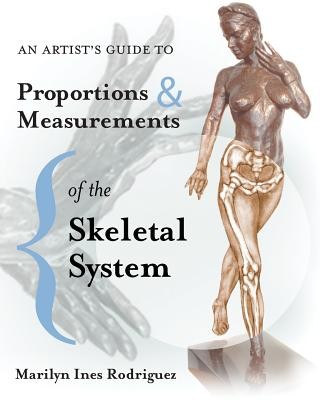| An Artist's Guide to Proportions & Measurements of the Skeletal System Contributor(s): Rodriguez, Marilyn Ines (Author) |
|
 |
ISBN: 1497403936 ISBN-13: 9781497403932 Publisher: Createspace Independent Publishing Platform OUR PRICE: $18.95 Product Type: Paperback Published: February 2014 |
| Additional Information |
| BISAC Categories: - Art | Techniques - Sculpting - Art | Study & Teaching |
| Physical Information: 0.49" H x 8" W x 10" (1.04 lbs) 234 pages |
| Descriptions, Reviews, Etc. |
| Publisher Description: Award Wining book at the International Latino Book Awards 2016 Teaching classical figure sculpture since 1996 has given me insight into student's common mistakes and questions. I have heard over and over: "Are my proportions correct?" "Is the head too big?" "Do the hands look all right?" "Are the legs too short?" These are the questions that compelled me to write this book. This is not your typical anatomy book, there are plenty good ones already. This is a GUIDE, a WORKBOOK full of useful information about the human figure, its relative proportions, measurements and many more surprises. The best use for the book is to have it opened next to you as you work on your piece, using it as a quick guide. My main goal was to teach artists in a very clear, easy to understand and concise way the most important "Human Relative Proportions" and "Prominent Bone Landmarks" of the human figure This book contains 234 pages and over 200 original illustrations. In order to make the book as condensed and visually friendly as possible, I have limited the technical terms to those which I consider essential to an art student. Instructional illustrations appear on the right-hand page and corresponding explanations on the left. I tried not to crowd the illustration with too much information so that students can find answers at a glance, and eventually overcome the need to read the explanation. I wanted to include what I consider essential and basic knowledge to any art student in a SIMPLIFIED AND EASY WAY to follow. I have carefully selected the "Relative Proportions" in this book according to their level of usefulness and the ease of measurement with a respectable degree of accuracy. YOU CAN GO TO VARIOUS SOURCES FOR YOUR INFORMATION, BUT THIS BOOK WILL PULL THEM TOGETHER IN A WAY I HAVE TO FIND IN ANY OTHER BOOK. Also included in this chapter are facts and observations that I believe to be of interest to an artist. This book is mainly dedicated to the human skeletal system, as bones are the basic structure and primary point of departure of relative proportions. I begin with an introduction of the skeletal system, with basically accurate and clear bone illustrations without the distraction of any other anatomical parts. In subsequent chapters, my main objective is to provide the artist with useful and practical information over anatomical clarity. Learning the human skeletal system is the foundation but it is not nearly enough for the artist without knowing the subcutaneous bone landmarks. Bone landmarks are so fundamental to the artist that I have dedicated a whole chapter to their study. Without accurate representation, the most perfectly proportioned figure will lack structure and realism. A comprehensive step-by-step guide as to how best to represent hands, feet, and ears are included. All are body parts that are a main source of intimidation for most students, and are cartilaginous in nature such as the ears, or exhibit a great number of subcutaneous bone landmarks such as in the hands and feet. This book ends with a compilation of exchanges I have had with my students in which I share my experience and observations on diverse subject matters, hoping to enhance your work. Ultimately there are no shortcuts in becoming a fully skilled artist. It requires a huge commitment, discipline, and practice. In the end, we usually see what we expect to see, and we expect to see what we know; therefore a large portion of the quality of your work has a direct correlation to what you have learned. |